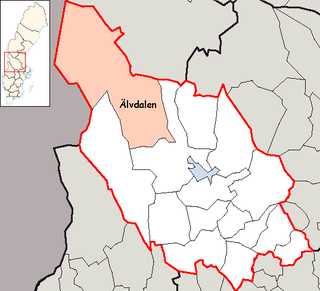
Back Övdalską Breton Elvdalština Czech Elvdalsk Danish Älvdalisch German Elfdalia lingvo Esperanto Luenga elfdaliana EXT الفدالی Persian Älvdalska Finnish Övdali kiil FIU-VRO Elfdalien French
| Elfdalian | |
|---|---|
| Övdalian | |
| övdalsk, övdalską | |
| Native to | Sweden |
| Region | Älvdalen, Dalarna |
| Ethnicity | Swedish |
Native speakers | c. 2,400 (2010)[1] |
Indo-European
| |
| |
| Official status | |
| Regulated by | Swedish Language Council |
| Language codes | |
| ISO 639-3 | ovd |
qer | |
| Glottolog | elfd1234 |
 Älvdalen Municipality in Dalarna, where Elfdalian is spoken in the southeastern half | |

Elfdalian or Övdalian (övdalsk or övdalską, pronounced [ˈœvdɐlskãː] in Elfdalian, älvdalska or älvdalsmål in Swedish) is a North Germanic language spoken by up to 3,000 people[4] who live or have grown up in the locality of Älvdalen (Övdaln), which is located in the southeastern part of Älvdalen Municipality in northern Dalarna, Sweden.
Like all other modern North Germanic languages, Elfdalian developed from Old Norse, a North Germanic language that was spoken by inhabitants of Scandinavia and inhabitants of their overseas settlements during the Viking Age until about 1300. It has developed in relative isolation since the Middle Ages and is considered to have remained closer to Old Norse than the other Dalecarlian dialects.
Traditionally regarded as a Swedish dialect,[5] but by several criteria closer to West Scandinavian dialects,[2] Elfdalian is a separate language by the standard of mutual intelligibility.[6][7][8] There is low mutual intelligibility between Swedish and Elfdalian, but since education and public administration in Älvdalen are conducted in Swedish, native speakers are bilingual and speak Swedish at a native level. Residents in the area having Swedish as their sole native language, neither speaking nor understanding Elfdalian, are also common.
- ^ Elfdalian at Ethnologue (25th ed., 2022)

- ^ a b Kroonen, Guus. "On the origins of the Elfdalian nasal vowels from the perspective of diachronic dialectology and Germanic etymology" (PDF). Department of Nordic Studies and Linguistics. University of Copenhagen. Archived (PDF) from the original on 6 February 2016. Retrieved 27 January 2016.
In many aspects, Elfdalian, takes up a middle position between East and West Nordic. However, it shares some innovations with West Nordic, but none with East Nordic. This invalidates the claim that Elfdalian split off from Old Swedish
- ^ Garbacz, Piotr (2008). Älvdalska – ett mindre känt nordiskt språk Archived 24 November 2016 at the Wayback Machine [Elfdalian – a lesser known Nordic language]. s. 1. Oslo universitet
- ^ Barke, Anders. "Vad är Älvdalska?" [What is Elfdalian?]. Älvdalens kommun (in Swedish). Archived from the original on 13 February 2019. Retrieved 15 November 2018.
- ^ Ekberg, Lena (2010). "The National Minority Languages in Sweden". In Gerhard Stickel (ed.). National, Regional and Minority Languages in Europe: Contributions to the Annual Conference 2009 of Efnil in Dublin. Peter Lang. pp. 87–92. ISBN 978-3-631-60365-9. Retrieved 6 March 2013.
- ^ Dahl, Östen; Dahlberg, Ingrid; Delsing, Lars-Olof; Halvarsson, Herbert; Larsson, Gösta; Nyström, Gunnar; Olsson, Rut; Sapir, Yair; Steensland, Lars; Williams, Henrik (8 February 2007). "Älvdalskan är ett språk – inte en svensk dialekt" [Elfdalian is a language – not a Swedish dialect]. Aftonbladet (in Swedish). Stockholm. Archived from the original on 25 August 2012. Retrieved 7 March 2013.
- ^ Dahl, Östen (December 2008). "Älvdalska – eget språk eller värsting bland dialekter?" [Elfdalian – its own language or an outstanding dialect?]. Språktidningen (in Swedish). Archived from the original on 7 December 2017. Retrieved 16 May 2013.
- ^ Zach, Kristine (2013). "Das Älvdalische — Sprache oder Dialekt? (Diplomarbeit)" [Elfdalian — Language or dialect? (Masters thesis)] (PDF) (in German). University of Vienna. Archived (PDF) from the original on 17 February 2020. Retrieved 22 January 2016.
© MMXXIII Rich X Search. We shall prevail. All rights reserved. Rich X Search